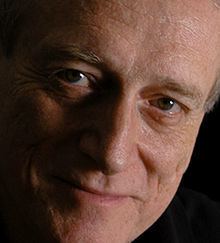Name George Quasha | Role Artist | |
 | ||
Education New York University (1966) Books Axial Stones, Ainu dreams, Viewer, Verbal Paradise: Preverbs, Tall Ships | ||
George quasha axial stones in process
George Quasha is an American artist and poet who works across media, exploring a principle in common within language, sculpture, drawing, video, sound and music, installation, and performance. This principle, axiality, he defines as "the principle of free-moving order, liminality, and precarious, spontaneous configuration."
Contents
His axial stones are delicately balanced sculptures of two (occasionally three) stones positioned one upon another at the most precarious point discovered. Quasha’s sculptural process, more tactile and body-centered than visual, follows strict rules: specific “found” stones must be felt to attract each other; one stone must find its place on the other at the smallest available point of contact; no adhesive is permissible; and neither stone may be modified in any way. In this context, "axial" refers to the invisible axis that comes into focus at the moment of precarious balance. In addition to axial stones, Quasha has created axial drawings, executed with two hands simultaneously; axial drumming/music, non-metrical pulsation-based rhythm arising from interaction of instruments, sounds, surfaces; and axial poems, discovering points of charged variability in actual language use and bringing about a self-actualizing process.
Solo exhibitions of his axial stones and axial drawings have taken place at the Baumgartner Gallery in New York (Chelsea), the Slought Foundation in Philadelphia, and the Samuel Dorsky Museum of Art at SUNY New Paltz. This work is also featured in the book, Axial Stones: An Art of Precarious Balance, Foreword by Carter Ratcliff (North Atlantic Books: Berkeley, 2006).
For his video installation work art is: Speaking Portraits, which includes multiple volumes (art is, music is, poetry is, he has recorded over 800 artists, poets, and composers (in 11 countries and 21 languages). Just the face of each person is shown at the moment of saying, for instance, what art is. The work has been exhibited at the Snite Museum of Art (University of Notre Dame), at White Box in Chelsea, at the Samuel Dorsky Museum (SUNY New Paltz), and in several other countries (including France and India), and has been featured in several biennials (Wroclaw, Poland; Geneva, Switzerland; Kingston, New York). Further extensions of this work in speaking portraiture include myth is and peace is. His other work in axial video (including Pulp Friction, Axial Objects, Verbal Objects, Axial Landscapes) has appeared internationally in museums, galleries, schools, and biennials. These and other works are extended and updated regularly at www.quasha.com.
A 30-year performance collaboration (video/language/sound) continues with Gary Hill and Charles Stein; recently, with the advent of axial drumming/music, he has been performing with the composer David Arner.
His other 14 books include poetry (Somapoetics, Giving the Lily Back Her Hands, Ainu Dreams [with Chie Hasegawa], Verbal Paradise (preverbs) (as the first of a 5 volume work of "preverbs"); anthologies (America a Prophecy [with Jerome Rothenberg], Open Poetry [with Ronald Gross], An Active Anthology [with Susan Quasha], The Station Hill Blanchot Reader [with Charles Stein]); and writing on art (Gary Hill: Language Willing; with Charles Stein: Tall Ships, HanD HearD/liminal objects, Viewer, and An Art of Limina: Gary Hill's Works and Writings, Foreword by Lynne Cooke.
The latter work, an art book with extensive text (640 pgs, 1000 illus,) comprises a full-scale poetics of language and art process, with a theory of principle art as distinguished from, but not exclusive of, conceptual art. His recently emerging 5-vol. work of preverbs extends this principle (axial/liminal/configurative) in discrete acts of language called preverbs. He writes in the second vol.: "A preverb, in this special usage, as distinguished from proverb, is a saying in a state of language that stands previous to any claim on wisdom. Each preverb incorporates—takes into its language body—a core issue or notion which, if mastered or somehow resolved, could stand as a point of reference for future thought and therefore condition thinking in a consistent way; if left unmastered and unresolved, because still or even additionally polysemous in its state of language, it becomes a matrix of yet unrealized thinking and a spur to further nature. A preverb works in such a way that a given issue is intensified in all its life/art ambiguity. It contains a certain wild, which here aims to preserve the rich complexity and uncertainty of the impulse to state truth and to protect the mind against oversimplified interpretation."
In 2006 he was awarded a Guggenheim Fellowship in video art. Other awards include a National Endowment for the Arts Fellowship in poetry. He has taught at Stony Brook University (SUNY), Bard College, New School University (Graduate Anthropology Department), and Naropa University. With Susan Quasha he is founder/publisher of Barrytown/Station Hill Press, whose mission is to challenge and expand conceptions of human possibility. Born on July 14, 1942 in White Plains, New York, he now lives with Susan Quasha in Barrytown, New York.
